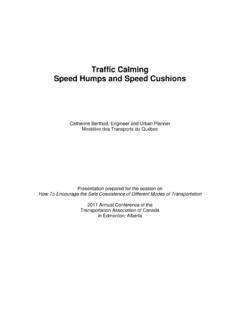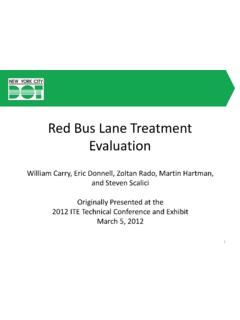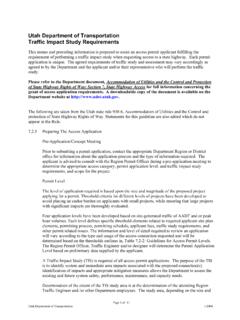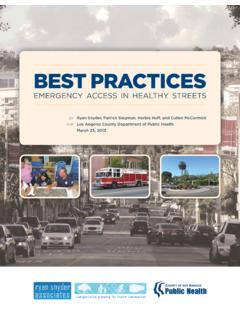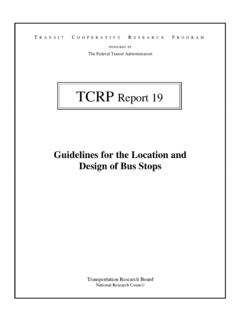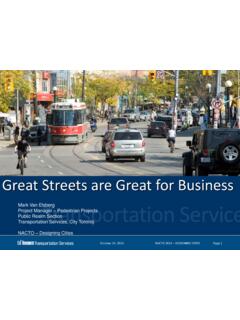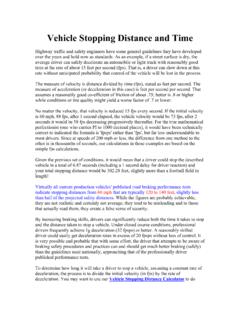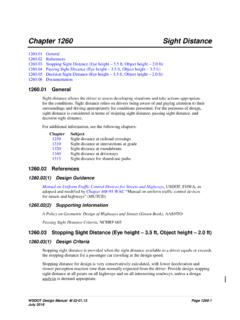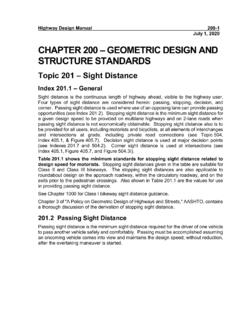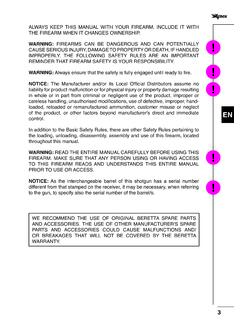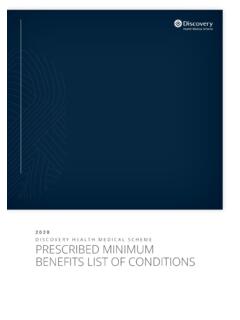Transcription of Sight Distance Studies - National Association of City ...
1 Select LocationComplete StudyPrepareDocumentSight Distance1. Review ordinances/regulations,speed Studies , crash analysis, andcitizen input1. Plan the data collection2. Review historical data trends2. Site visitations1. Data collection2. Determine alternatives1. Finalize the report3. Implement improvements2. Communicate the results3. Consult with other agencies3. Review with neighborhood associations/property owners Sight Distance INTRODUCTIONINTRODUCTION Sight Distance is the length of roadway visible to a driver. The three types of Sight Distance common in roadway design are intersection Sight Distance , stopping Sight Distance , and passing Sight Distance .
2 This handbook will not discuss passing Sight Distance because it primarily occurs in rural settings and this handbook generally addresses urban areas. (Information on passing Sight Distance can be found in Chapter 3 of the AASHTO Green Book and in the CTRE Iowa Traffic Control Devices and Pavement Markings manual.) INTERSECTION Sight DINTERSECTION Sight DISTANCEISTANCE The driver of a vehicle approaching or departing from an intersection should have an unobstructed view of the intersection, including any traffic control devices, and sufficient lengths along the intersecting highway to permit the driver to anticipate and avoid potential collisions (Maze and Plazak 2000).
3 These unobstructed views form triangular areas known as Sight triangles. A typical intersection is divided into areas between each leg known as quadrants. There may be three quadrants, such as for a T intersection, or four, such as for a four-legged intersection. Sight triangles are the specified areas along an intersection s approach legs and across the included corners (see Figures and for an illustration). These areas should be clear of obstructions that might block a driver s view of conflicting vehicles or pedestrians. The two types of Sight triangles are approach Sight triangles and departure Sight triangles (AASHTO, Green Book, 2001).
4 ApproApproach Sight Trianglesach Sight Triangles Approach Sight triangles provide the driver of a vehicle approaching an intersection an unobstructed view of any conflicting vehicles or pedestrians. These triangular areas should be large enough that drivers can see approaching vehicles and pedestrians in sufficient time to slow or stop and avoid a crash. Approach Sight triangles are illustrated in Figure Sight Distance Major StreetMajor StreetMinor StreetMinor StreetDecision PointDecision PointN Figure Approach Sight Triangles Departure Sight TrianglesDeparture Sight Triangles Departure Sight triangles provide adequate Sight Distance for a stopped driver on a minor roadway to depart from the intersection and enter or cross the major roadway.
5 These Sight triangles should be provided in each quadrant of a controlled intersection. Departure Sight triangles are illustrated in Figure Major StreetMajor StreetMinor StreetMinor StreetDecision PointDecision PointN Figure Departure Sight Triangles Sight Distance Obstructions within Sight TrianglesObstructions within Sight Triangles To determine whether an object is a Sight obstruction , consider both the horizontal and vertical alignment of both roadways, as well as the height and position of the object (AASHTO, Green Book). For passenger vehicles, it is assumed that the driver s eye height is feet and the height of an approaching vehicle is feet above the roadway surface, as illustrated in Figure At the decision point, as shown in Figure , the driver s eye height is used for measurement.
6 Major StreetMinor StreetDecision PointDriver Eye feetVehicle feet Figure Heights Pertaining to Sight Triangles Any object within the Sight triangle that would obstruct the driver s view of an approaching vehicle ( feet in height) should be removed or modified or appropriate traffic control devices should be installed as per the Manual on Uniform Traffic Control Devices. Obstructions within Sight triangles could be buildings, vehicles, hedges, trees, bushes, tall crops, walls, fences, etc. Figure shows a clear Sight triangle and an obstructed Sight triangle. Sight Distance Major StreetMajor StreetMinor StreetMinor StreetDecision PointDecision PointObstructionClear Sight TriangleObstructed Sight TriangleRowRowN Figure Clear versus Obstructed Sight Triangles Sight Distance STUDYSIGHT Distance STUDY METHODS METHODS Different types of traffic control require different Sight distances.
7 For example, intersections with no control require adequate Distance for the approaching vehicle to identify any conflicts in or approaching the intersection before entering. An approach Sight triangle is used for this analysis. However, intersections with stop or yield control require drivers to stop or yield at the intersection, check for approaching vehicles in the intersection, and then depart. A departure Sight triangle is used for this analysis. Sight Distance Study Preparation ChecklistSight Distance Study Preparation Checklist When preparing for an intersection Sight Distance study, use the checklist in Table The checklist may be modified or expanded as necessary.
8 Sight Distance Table Sight Distance Study Preparation Checklist Step When Complete Notes Obtain target and sighting rods Obtain measuring wheel Obtain hardhat and safety vest Obtain Sight Distance diagram form Select time and day Determine availability of observers Contact corresponding jurisdiction(s) Other: If an agency does not possess the equipment necessary to complete a Sight Distance study, it may be obtained from the Iowa DOT, another jurisdiction, or a responsible consulting firm. A blank Sight Distance diagram form is located in Appendix C. Information on contracting for a Sight Distance study, including a project work order example, is provided near the end of this chapter.
9 UNCONTROLLED INTERSEUNCONTROLLED INTERSECTIONSCTIONS For uncontrolled intersections, the drivers of both approaching vehicles should be able to see conflicting vehicles in adequate time to stop or slow to avoid a crash. The required Sight Distance for safe operation at an uncontrolled intersection is directly related to the vehicle speeds and the distances traveled during perception, reaction, and braking time. Table lists the minimum recommended Sight distances for specific design speeds. For example, if a vehicle is traveling 20 mph, a Sight Distance of 90 feet is the minimum recommended stopping Sight Distance . Table Minimum Recommended Sight Distances Vehicle Speed (mph) Stopping Sight Distance (feet) 15 70 20 90 25 115 30 140 35 165 40 195 45 220 50 245 55 285 Note: Distances are from the 2001 AASHTO Green Book and 2001 AASHTO Little Green Book.
10 Distances may change in future versions. Sight Distance Key Steps to a Sight Distance Study at an Uncontrolled Key Steps to a Sight Distance Study at an Uncontrolled IntersectionIntersection A Sight Distance study at an uncontrolled intersection includes four key steps: 1. Determine the minimum recommended Sight Distance . 2. Obtain or construct sighting and target rods. 3. Measure current Sight distances and record observations. 4. Perform Sight Distance analysis. Determine the Minimum Recommended Stopping Sight Distance Determine the minimum Sight Distance for the posted or operating speed at the intersecting roadway (see Table ). Obtain or Construct Sighting and Target Rods Sighting and target rods are illustrated in Figure The target rod can be constructed out of 2-inch by wood.

